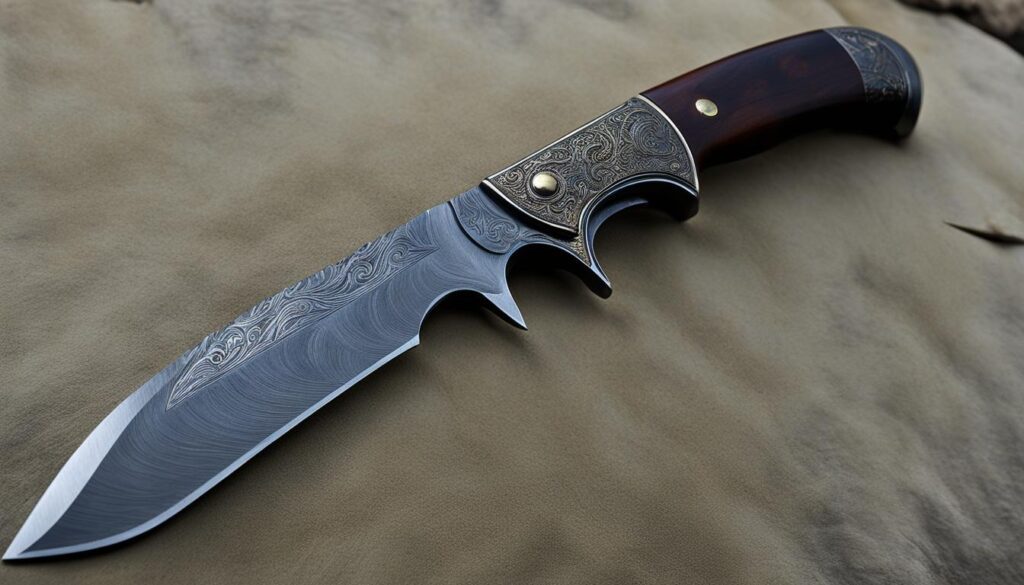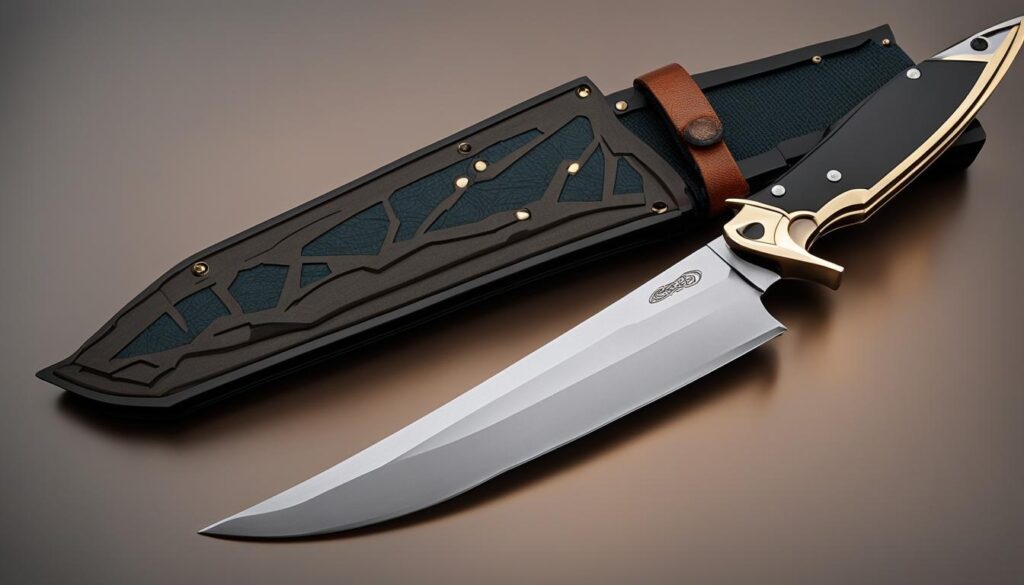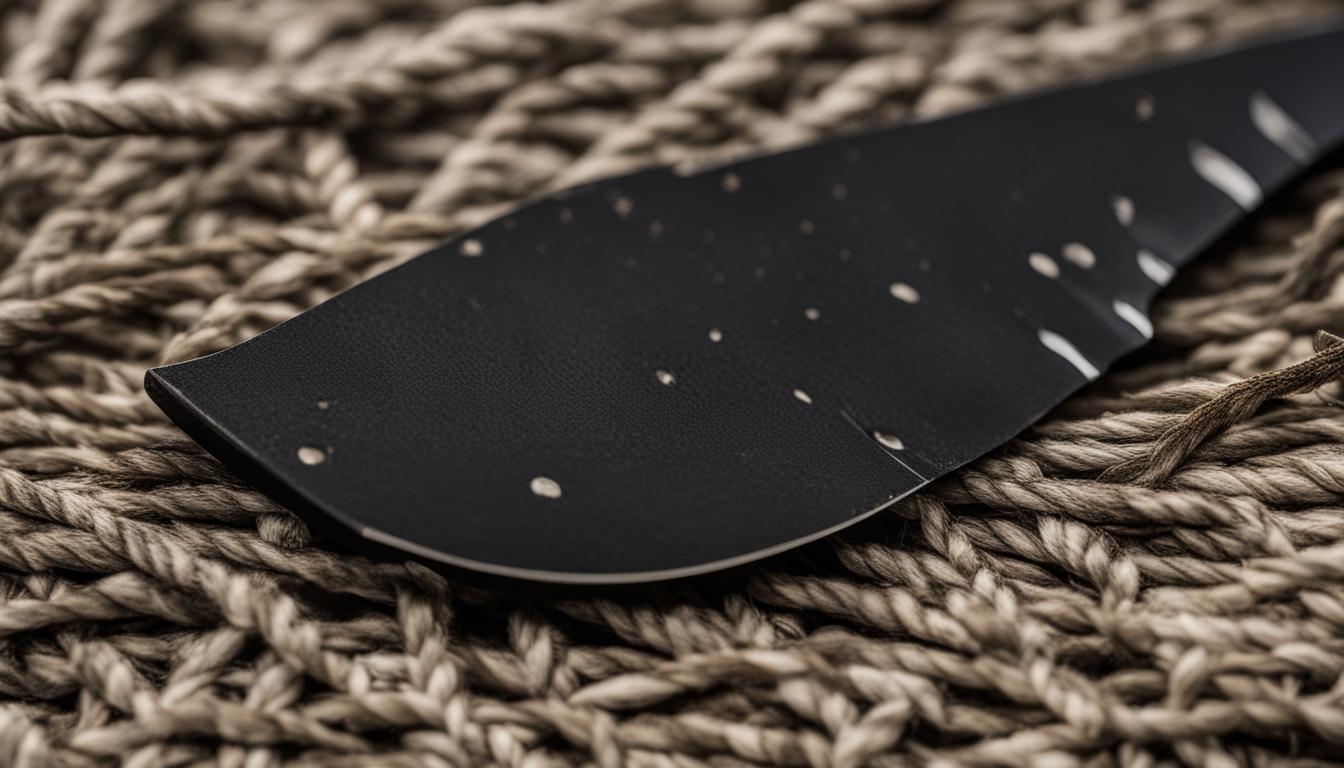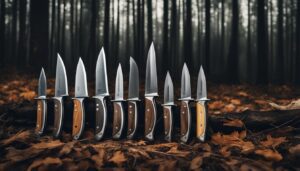The choice of hunting knife blade size is crucial for optimal performance in the field. The right blade size allows for better control and precision while undertaking various tasks such as field dressing, skinning, and caring for game. Understanding the different blade lengths and their advantages is key to selecting the perfect hunting knife for your needs.
Key Takeaways:
- Choosing the right blade size is essential for control and precision in hunting tasks.
- Understanding the different blade lengths is key to finding the perfect hunting knife.
- Blade size affects performance in tasks such as field dressing and skinning.
- Consider the type of hunting you will be doing when selecting a blade size.
- Optimal performance in the field relies on choosing the right hunting knife blade size.
The Impact of Blade Shape on Performance
The shape of the hunting knife blade plays a significant role in determining its performance and functionality in the field. Different blade shapes offer distinct advantages for specific hunting tasks, ensuring optimal efficiency and effectiveness.
The Clip Point: Balanced Control and Precision
The Clip Point blade shape features a concave curve that terminates in a sharp point. This design allows for precise control and enhanced tip strength, making it ideal for tasks that require precision, such as detail work and piercing. The Clip Point’s narrow tip also facilitates better penetration, making it suitable for field dressing and other delicate tasks.
The Drop Point: Enhanced Cutting and Control
The Drop Point blade shape is characterized by a convex curve that slopes gradually from the handle to the point. This design provides increased control and stability, making it well-suited for general hunting tasks. The convex edge encourages efficient cutting and slicing, while the sturdy tip ensures durability and versatility. The Drop Point blade is a popular choice for skinning and field dressing.
The Trailing Point: Ideal for Skinning and Slicing
The Trailing Point blade shape features a long, sweeping curve that extends beyond the spine of the knife. This design allows for effortless skinning and slicing by reducing the chances of puncturing the hide. The extended tip facilitates delicate maneuvering and precise cuts, making it perfect for skinning animals with tightly attached hides, such as rabbits and deer.
Table: Comparison of Hunting Knife Blade Shapes
| Blade Shape | Advantages |
|---|---|
| Clip Point | Precise control, enhanced tip strength |
| Drop Point | Increased cutting control, durability |
| Trailing Point | Effortless skinning, precise slicing |
Considering Blade Length for Optimal Control
When it comes to choosing a hunting knife, blade length is an important factor to consider. The length of the blade directly affects your control and precision while performing tasks in the field. Whether you’re caping, skinning small game, or tackling larger game animals, selecting the right blade length can make a significant difference in your hunting experience.
A shorter blade, typically around 3 inches, offers better control and maneuverability. This makes it ideal for delicate tasks such as caping and skinning small game, where precision is key. The shorter length allows for more precise cuts and reduces the risk of damaging valuable hides or meat. Additionally, a shorter blade is usually lighter, making it easier to carry and handle for extended periods.
On the other hand, a longer blade provides more reach and cutting power, making it suitable for skinning larger game animals and performing heavy-duty tasks such as chopping wood. A blade length of around 4 to 6 inches strikes a balance between reach and control, making it a versatile choice for various hunting scenarios. With a longer blade, you can easily navigate through the layers of hide and meat when field dressing larger game.
| Blade Length | Recommended Use |
|---|---|
| 3 inches | Caping, skinning small game |
| 4-6 inches | Skinning larger game, field dressing |
Ultimately, the choice of blade length depends on the type of hunting you will be doing and your personal preferences. It’s important to consider the specific tasks you expect your hunting knife to perform and select a blade length that aligns with those requirements. By choosing the right blade length, you can ensure optimal control, precision, and performance in the field.
Selecting the Right Steel for Durability and Sharpness
When choosing a hunting knife, one of the key factors to consider is the type of steel used in the blade. The blade’s steel composition greatly impacts its durability, sharpness retention, and overall performance. With a wide variety of steel options available, it can be overwhelming to determine which one is best suited to your needs. Understanding the different blade materials and their characteristics will help you make an informed decision.
Popular stainless steel options for hunting knife blades include 154CM, ATS34, and 440C. These steels are known for their corrosion resistance, making them ideal for outdoor use. Stainless steel blades require less maintenance and are less prone to rusting, which is especially beneficial in wet and humid environments. However, it is important to note that stainless steel may not be as hard as some non-stainless options, which can affect its edge retention.
Non-stainless steel options like O1 and D2 offer unique advantages in terms of hardness and toughness. These steels can be hardened to higher levels, resulting in excellent edge retention and durability. They are particularly suitable for tasks that require a sharp edge, such as field dressing and skinning larger game animals. However, non-stainless steels may require more maintenance to prevent rusting and corrosion.
Table: Comparison of Hunting Knife Blade Materials
| Steel Type | Advantages | Disadvantages |
|---|---|---|
| 154CM | Corrosion resistance, good edge retention | May be less hard compared to non-stainless options |
| ATS34 | High corrosion resistance, excellent edge retention | Slightly more expensive, may require professional sharpening |
| 440C | Good corrosion resistance, easy to sharpen | May not be as hard as other non-stainless options |
| O1 | High hardness, excellent edge retention | Requires regular maintenance to prevent rusting |
| D2 | Extreme hardness, superior edge retention | Requires regular maintenance to prevent rusting |
When selecting the right steel for your hunting knife, consider the type of game you’ll be hunting and the tasks you’ll be performing. Smaller game may benefit from a hard steel blade that maintains its sharpness for longer periods, while larger game may require a tougher steel blade that can withstand more demanding tasks. Ultimately, finding the balance between hardness, toughness, and corrosion resistance is essential for optimal performance in the field.
Remember, the choice of steel is only one aspect of selecting the perfect hunting knife. It’s important to consider other factors such as blade shape, length, and overall design to ensure the knife meets your specific needs and preferences.

Balancing Functionality and Aesthetics
When it comes to choosing a hunting knife, functionality is a top priority. However, the aesthetics and overall design of the knife are also important factors to consider. A well-designed hunting knife not only performs its intended tasks efficiently but also adds to the overall enjoyment of the hunting experience.
The design of a hunting knife encompasses various elements such as the handle material, blade finish, and overall shape. These aspects contribute to both the visual appeal and the comfort of the knife in hand. It’s essential to find a knife that not only looks good but also feels comfortable and secure during use.
Aesthetics can be a personal preference, and there are a wide variety of hunting knife designs available to suit different tastes. Some hunters prefer a classic and timeless design, while others may opt for a more modern or tactical look. Whether you prefer a traditional wooden handle or a more contemporary synthetic material, finding a design that resonates with you is key.


Quote:
“A well-designed hunting knife not only performs its intended tasks efficiently but also adds to the overall enjoyment of the hunting experience.”
However, it’s important to strike a balance between functionality and aesthetics. While a visually appealing knife may catch your eye, it’s crucial to ensure that it can perform the necessary tasks effectively. Consider the blade shape, length, and steel type to ensure that the knife is suitable for the specific hunting tasks you plan to undertake.
Table: Types of Hunting Knife Designs
| Design | Description |
|---|---|
| Classic | Features a traditional design with a wooden handle and a simple yet elegant blade shape. |
| Tactical | Has a more modern and tactical look, often with a synthetic handle and a serrated edge for versatility. |
| Custom | Unique and handcrafted designs that offer a personalized touch, often made by skilled artisans. |
| Skinning | Specifically designed for efficient skinning with features like a specialized blade shape and ergonomic handle. |
The table above showcases different types of hunting knife designs, illustrating the variety of options available to hunters. Each design has its own characteristics and is tailored to specific hunting tasks or personal preferences.
Conclusion
After careful consideration, I have come to the conclusion that selecting the right hunting knife is essential for a successful and enjoyable hunting experience. The blade size, shape, length, steel type, and overall design all contribute to the functionality and effectiveness of a hunting knife.
When choosing a hunting knife, it is important to understand the specific tasks you will be performing in the field. Consider the blade size and shape that best suits your needs. A smaller blade size offers greater control and precision for tasks like caping and skinning small game, while a larger blade size provides more reach and is suitable for skinning larger game animals or performing heavy-duty tasks like chopping wood.
The type of steel used in the blade is another critical factor to consider. Stainless steel options like 154CM, ATS34, and 440C offer excellent corrosion resistance, while non-stainless options like O1 and D2 provide unique hardness and toughness characteristics. The choice of steel depends on the type of game you hunt, as smaller game benefits from a hard steel blade and larger game requires a tough steel blade.
Lastly, don’t forget about the aesthetics and overall design of the hunting knife. Choose a knife that not only appeals to you visually but also feels comfortable in your hand. Remember to consider factors such as blade shape, length, steel type, and overall size before making your final decision.
In conclusion, selecting the right hunting knife requires careful consideration of various factors. By choosing the right blade size, shape, length, steel type, and design that align with your hunting needs and personal preferences, you can ensure that your hunting experiences are successful and enjoyable.
FAQ
Why is the choice of hunting knife blade size important?
The right blade size allows for better control and precision while undertaking various tasks such as field dressing, skinning, and caring for game.
What are the popular blade shapes for hunting knives?
The popular blade shapes for hunting knives are the Clip Point, Drop Point, and Trailing Point.
How does blade length affect the functionality of a hunting knife?
A shorter blade offers greater control and precision, while a longer blade provides more reach for heavy-duty tasks.
What types of steel are commonly used in hunting knife blades?
Popular stainless steel options include 154CM, ATS34, and 440C, while non-stainless options like O1 and D2 offer unique hardness and toughness characteristics.
What role does aesthetics play in selecting a hunting knife?
It is important to choose a hunting knife that appeals to you visually and feels comfortable in your hand.
What factors should I consider when choosing a hunting knife?
Consider factors such as blade shape, length, steel type, functionality, and personal preference.
How do I select the perfect hunting knife?
Choosing the perfect hunting knife involves considering factors such as blade shape, length, steel type, functionality, and personal preference.





